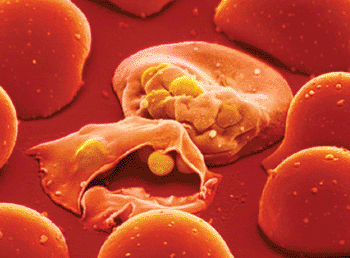Clinical Relevance of Biomarkers Evaluated for Malaria
By LabMedica International staff writers
Posted on 01 Aug 2013
Early diagnosis and risk stratification is important in patients with Plasmodium falciparum malaria for rapid initiation of antimalarial treatment and prevention of complications.Posted on 01 Aug 2013
Routine laboratory values do not correlate well with disease severity and therefore it is important to determine the diagnostic and prognostic value of several biomarkers related to inflammation; endothelial and cardiac dysfunction; coagulation, and hemolysis.

Image: Malaria parasites infect two blood cells (Photo courtesy of Lennart Nilsson).
Scientists at the University Medical Center Hamburg-Eppendorf (Germany) carried out a prospective case-control study of 79 adult travelers with both uncomplicated and complicated P. falciparum malaria between 2007 and 2011; 41 healthy subjects were included as controls. Blood samples were obtained within 24 hours after first consultation to assess routine laboratory values as well as markers related to inflammation, plasma protein-A (PAPP-A), copeptin, C-reactive protein (CRP); endothelial activation, myeloperoxidase (MPO), elastase-2, endothelin-1, soluble intercellular adhesion molecule-1 (sICAM-1), soluble vascular adhesion molecule-1 (sVCAM-1); cardiac function, N-terminal pro-brain natriuretic peptide (NT-proBNP), midregional pro-atrial natriuretic peptide (MR-proANP); coagulation, fibrinogen, D-dimers, platelet count; and hemolysis, lactate dehydrogenase (LDH).
Twelve (15.2%) patients had severe P. falciparum malaria. In the patient group, significant thrombocytopenia was found, all other markers were significantly elevated except for PAPP-A. Median values of CRP, MPO, sICAM-1, sVCAM-1, D-dimers, platelets, and LDH differed significantly between the two groups. However further analysis via receiver operating curve (AUROC) showed large 95% confidence intervals (CI), indicating poor association with disease severity for all markers. No significant association was found for copeptin, elastase-2, or fibrinogen. The performance was best for CRP, followed by MPO, D-dimers, elastase-2, and sICAM-1, but biomarker levels did not correlate well with disease severity. Some commercially available immunofluorescence assays were provided by Thermo Scientific (Hennigsdorf, Germany).
The authors concluded that the combination of travel history, fever prior to blood sampling, and CRP serum levels above or below 10.8 mg/L upon hospital admission, best discriminated between malaria patients and control individuals. None of the biomarkers studied predicted the presence or the development of malaria complications, neither at the time of admission nor during hospitalization. The study was published on July 16, 2013, in the Malaria Journal.
Related Links:
University Medical Center Hamburg-Eppendorf
Thermo Scientific














